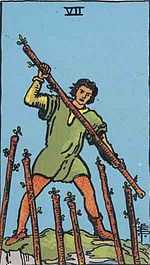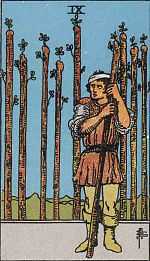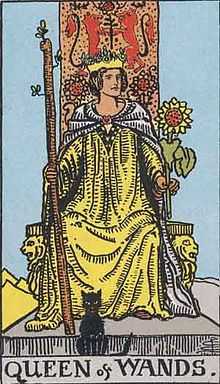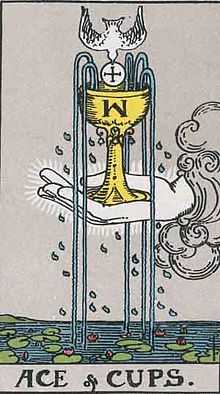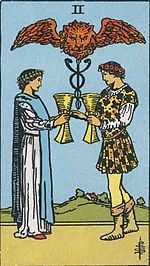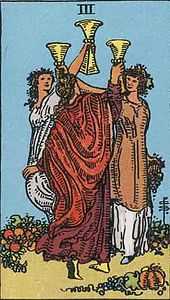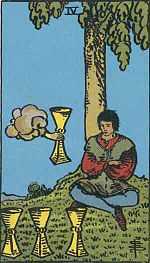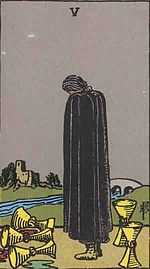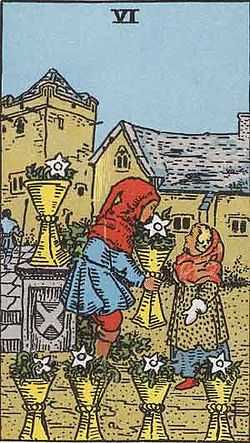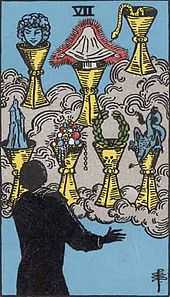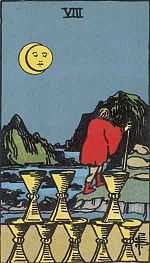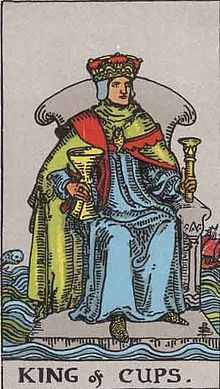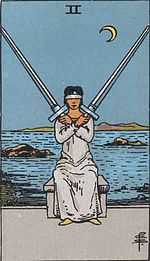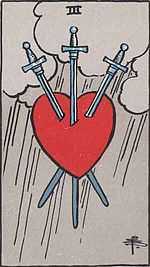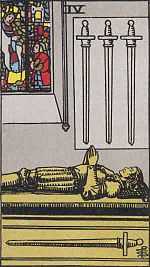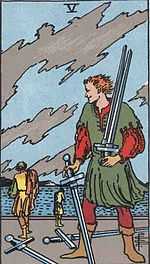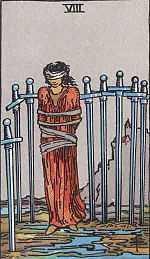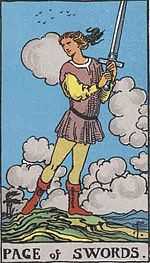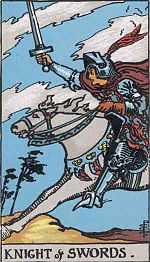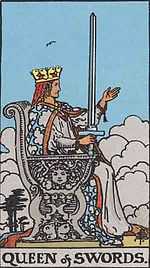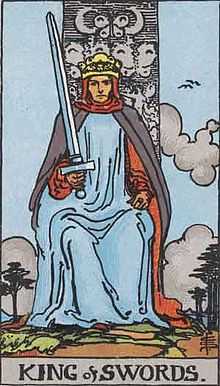Rider-Waite tarot deck
The Rider-Waite tarot deck is one of the most popular Tarot decks in use today in the English-speaking world[1] (The Tarot de Marseille being the most popular deck in Latin countries). [citation needed] Other suggested names for this deck include the Rider-Waite-Smith, Waite-Smith, Waite-Colman Smith or simply the Rider deck. The cards were drawn by illustrator Pamela Colman Smith from the instructions of academic and mystic A. E. Waite, and published by the Rider Company.
Overview
While the images are deceptively simple, almost childlike, the details and backgrounds hold a wealth of symbolism. Some imagery remains close to that found in earlier decks, but overall the Waite-Smith card designs represent a substantial departure from their predecessors. Among other changes, Waite had the Christian imagery of most older tarot decks' cards toned down—the 'Pope' card became the 'Hierophant', the 'Papess' became the 'High Priestess'. The Minor Arcana are illustrated with detailed scenes and images by Smith, again a departure from many earlier decks with much simpler designs for the Minor Arcana but aligning this deck with, for example, the Sola Busca Tarot. The symbols used were influenced by the 19th century magician and occultist Eliphas Levi.
Publication
The cards were originally published in 1910 by the publisher William Rider & Son of London. The following year, a small guide by A.E. Waite entitled The Key to the Tarot was bundled with the cards, providing an overview of the traditions and history behind the cards, criticism of various interpretations, and extensive descriptions of their symbols. The year after that, a revised version, The Pictorial Key to the Tarot, was issued that featured black-and-white plates of all 78 of Smith's cards. Several later versions of the deck, such as the Universal Waite deck, copy the Smith line drawings with minor changes and add more sophisticated coloring.
Copyright status
USGames, Inc has a copyright claim on an updated version of the deck published in 1971. This copyright, however, only covers new material added to the preexisting work (for example, designs on the card backs and the box). In accordance with the laws of the United Kingdom, the country of original publication of the cards, the deck is now in the public domain as of 2012, corresponding to 70 years from the end of the year in which the copyright holder, Arthur Edward Waite, died.
Pamela Coleman Smith was only a 'hired' artist (under: 'work for hire') So this deck was owned solely by Arthur Edward Waite: As written here on the Wikipedia site: Quoting from: http://en.wikisource.org/wiki/Author:Arthur_Edward_Waite
"Some or all works by this author are in the public domain in the United States because they were published before January 1, 1923. Arthur Edward Waite, the author died in 1942, so works by this author are also in the public domain in countries and areas where the copyright term is the author's life plus 70 years or less. Works by this author may also be in the public domain in countries and areas with longer native copyright terms that apply the rule of the shorter term to foreign works."
His 'Public Domain' works include: The Pictorial Key to the Tarot (any versions published before January 1, 1923) ~ Along with the included 78 tarot card images that were designed by Pamela Coleman Smith (as a work for hire artist).
Influence
The Rider-Waite deck has been used in many television programs and motion pictures, notably in the James Bond motion picture Live and Let Die. (The deck was used along with a different deck created by artist Fergus Hall specifically for the film.)
The Rider-Waite deck has been used as an animated video backdrop in Madonna's Re-Invention World Tour 2004 for the song "Hollywood".
The Hermit card in the Rider-Waite deck has been frequently used by Led Zeppelin guitarist Jimmy Page. Most popularly in The Song Remains The Same and the inner sleeve of Led Zeppelin IV.
Major Arcana
-

0 - The Fool
-

I - The Magician
-

II - The High Priestess
-

III - The Empress
-

IV - The Emperor
-

V - The Hierophant
-

VI - The Lovers
-

VII - The Chariot
-

VIII - Strength
-

IX - The Hermit
-

X - Wheel of Fortune
-

XI - Justice
-

XII - The Hanged Man
-

XIII - Death
-

XIV - Temperance
-

XV - The Devil
-

XVI - The Tower
-

XVII - The Star
-

XVIII - The Moon
-

XIX - The Sun
-

XX - Judgement
-

XXI - The World
Minor Arcana
Wands
-
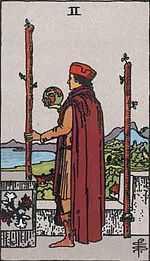
Two of Wands
-
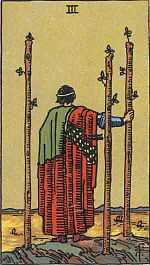
Three of Wands
-
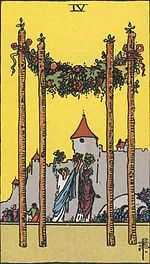
Four of Wands
-
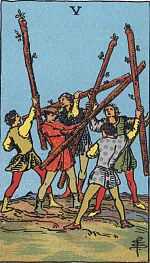
Five of Wands
Pentacles
-

Ace of Pentacles
-

Two of Pentacles
-

Three of Pentacles
-

Four of Pentacles
-

Five of Pentacles
-

Six of Pentacles
-

Seven of Pentacles
-

Eight of Pentacles
-

Nine of Pentacles
-

Ten of Pentacles
-

Page of Pentacles
-

Knight of Pentacles
-

Queen of Pentacles
-

King of Pentacles
Cups
Swords
References
- ↑ Visions and Prophecies. Alexandria, VA: Time-Life Books, 1988.
External links
-
 Learning materials related to A Psychological Interpretation of the Tarot at Wikiversity
Learning materials related to A Psychological Interpretation of the Tarot at Wikiversity


